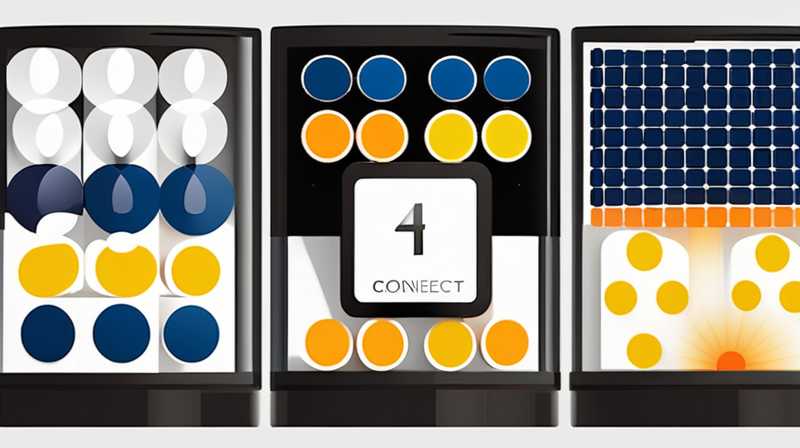
To connect four solar barrels efficiently, one needs to consider 1. the fundamental design, 2. the piping configuration, 3. the placement for optimal sunlight exposure, and 4. effective water circulation. Each component plays a vital role in enhancing the overall functionality of the solar barrel system.
1. THE FUNDAMENTAL DESIGN
A well-conceived design is vital for establishing an interconnected solar barrel system. Typically, solar barrels are constructed with materials designed to absorb sunlight and retain heat, maximizing energy efficiency for water heating. When connecting four barrels, it’s essential to determine the configuration—whether a linear, circular, or grid arrangement suits the space and intended usage.
The layout should promote easy water flow between barrels while maintaining accessibility for maintenance. Utilizing the proper insulation materials can also maximize heat retention, assisting in maintaining elevated temperatures throughout the day. Ensuring that valves or access points are conveniently located will facilitate easier checks and repairs when necessary.
2. THE PIPING CONFIGURATION
Proper piping is fundamental for interlinking solar barrels effectively. Each barrel requires specific inlet and outlet pipes. Connecting the barrels using a series of pipes forms a closed-loop system, which facilitates water circulation among the barrels. Using PVC or robust piping materials resistant to corrosion and UV exposure is recommended for longevity.
Ventilation is essential during installation. Adding pressure relief valves and air vents ensures that hot water can flow freely, preventing any build-up of excess pressure from leading to a malfunction or a dangerous situation. Additionally, a properly designed system can help maintain consistent temperatures, as the hot water will flow from the top of the barrels, pushing cooler water down as it moves through.
3. PLACEMENT FOR OPTIMAL SUNLIGHT EXPOSURE
To maximize energy capture, the positioning of the barrels plays a crucial role. Ideally, installations should face south (in the Northern Hemisphere) to trap sunlight during peak hours. Barrels should be placed without any obstructions, such as trees or buildings, which could interfere with direct sunlight access.
Angle adjustments can also improve efficiency. Using a tilt that aligns the barrels horizontally with the sun’s trajectory can drastically enhance energy absorption. Regular maintenance checks should be performed to ensure there is no accumulation of debris or dirt obstructing sunlight, as cleaning the barrels can significantly improve their performance.
4. EFFECTIVE WATER CIRCULATION
Ensuring that water circulates efficiently within the barrels is paramount for a successful system. Gravity and thermal dynamics will inherently drive some water movement, but additional methods such as pump-assisted systems can optimize performance further. Ensuring that pipes are of adequate sizes to allow for free movement without excessive resistance will enhance water flow.
Regular monitoring for blockages or leaks is essential for effective functioning. Incorporating a filtration system can prevent debris build-up, thereby maintaining clear passageways for smooth water transit. Making use of gauges enables users to observe the water temperature and flow rates, ensuring that the barrels operate effectively under various environmental conditions.
FAQ
WHAT MATERIALS ARE BEST FOR CONSTRUCTING SOLAR BARRELS?
When considering materials for solar barrels, one should prioritize items that excel in heat retention and durability. Common choices include thick plastic, metal, or insulated options that can withstand fluctuating temperatures and external elements. Plastic models are lighter and less prone to rust, while metal can offer enhanced longevity. It’s essential to utilize UV-resistant materials to prevent degradation from prolonged sunlight exposure.
Sealing is also integral; choosing materials that allow for tight fittings will prevent leaks that could undermine efficiency. It’s recommended to consider how the barrels will be mounted, as structural stability is crucial for long-term use. Each option has its own benefits, but combining insulation techniques will further improve energy efficiency. Regular upkeep to check for any wear and tear will ensure the longevity of the barrels.
HOW CAN I MAINTAIN MY SOLAR BARRELS EFFECTIVELY?
Maintenance is key to ensuring solar barrels operate effectively over time. Regular inspection of the pipes and seals is critical to identify potential leaks or deterioration, which can impede performance. Cleanliness cannot be overstated; keeping the exterior of the barrels free from debris and dirt buildup permits optimal sunlight exposure and improves heating efficiency.
Hydraulic components must also be monitored. Inspecting the pumping or filtration systems regularly will prevent blockages and ensure water circulates smoothly. End-of-season checks should include assessing insulation materials for UV degradation and checking for sediment accumulation inside the barrels. By prioritizing maintenance, users can expect an extended lifespan and improved efficiency from their solar barrel systems.
WHAT ARE THE COSTS ASSOCIATED WITH INSTALLING SOLAR BARRELS?
The expenses tied to installing solar barrels can differ significantly based on a multitude of factors. Primary costs include purchasing the barrels themselves, which can range from inexpensive plastic models to more robust insulated metal options. Installation expenses to consider include plumbing materials, supports, and any necessary labor.
In addition, ongoing costs such as maintenance and cleaning should be factored into the total investment. Energy savings can also be quantified; by reducing reliance on electric or gas heating, users may experience decreased utility bills over time. Grants or subsidies may be available that can offset initial installation costs, making solar barrels a more financially appealing option in the long run.
Bold emphasis on key components and considerations is crucial when constructing an interconnected solar barrel system. Each aspect, from initial design to late-stage maintenance, must be handled with a professional approach to ensure efficiency and longevity. Thoughtful planning, informed material choice, and systematic upkeep will yield benefits that surpass expectations, ensuring a reliable source of sustainable energy.
Original article by NenPower, If reposted, please credit the source: https://nenpower.com/blog/how-to-connect-four-solar-barrels/


